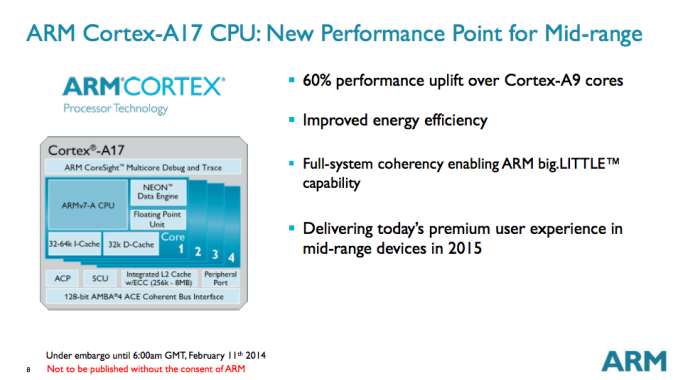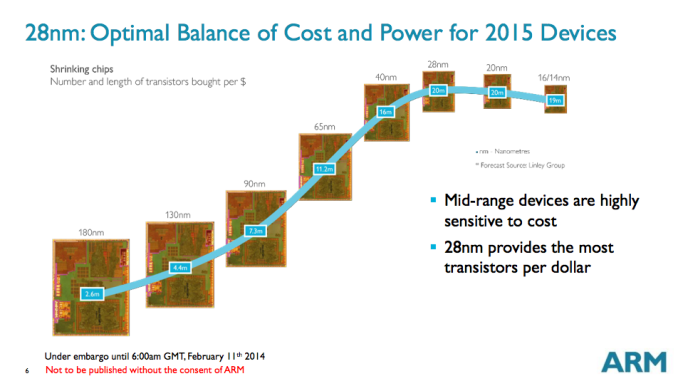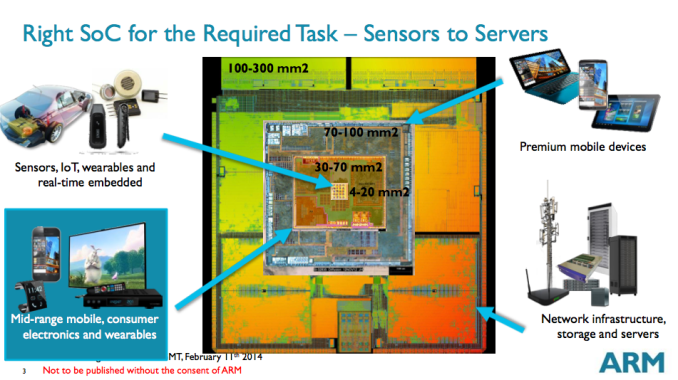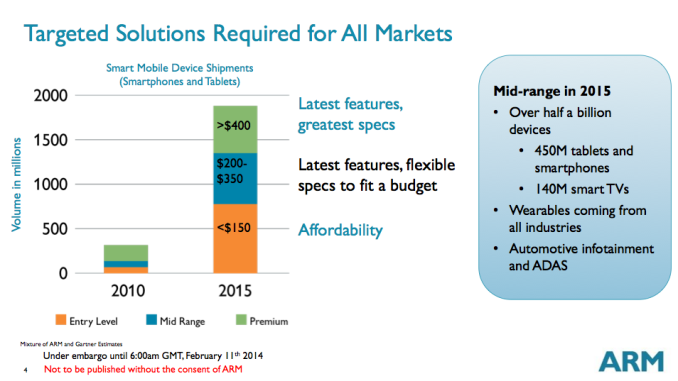ARM Cortex A17: An Evolved Cortex A12 for the Mainstream in 2015
by Anand Lal Shimpi on February 11, 2014 1:00 AM EST- Posted in
- SoCs
- Arm
- Smartphones
- Mobile
- Tablets
- Cortex A17

ARM has been doing a good job figuring out its PR strategy as of late. In the span of a couple of years we went from very little outward communication to semi-deep-dives on architecture and a regular cadence of IP disclosures. ARM continues its new trend today with the announcement of its 2015 mid-range CPU IP: the Cortex A17.
As its name implies, the Cortex A17 is a 32-bit ARMv7-A CPU design (64-bit ARMv8 cores belong to the Cortex A50 series - e.g. A53/A57). The best way to think about Cortex A17 is as an evolution of the recently announced Cortex A12, rather than anything to do with the Cortex A15. ARM's Cortex A17 takes the basic 2-wide out-of-order architecture of the Cortex A12 and improves it. Specific details are still light at this point, but I'm told that the front end and execution engine are similar to Cortex A12, with most of the performance/efficiency gains coming from improvements to the memory subsystem.
The result is a design that is roughly 60% faster than a Cortex A9r4 at a given frequency/process/memory interface (Cortex A12 is 40% faster than A9r4 under the same conditions). Using ARM's own DMIPS/MHz ratings I threw together a little table of relative/estimated performance ratings to help put all of this in perspective:
| ARM 2014/2015 CPU IP lineup | |||||||||
| CPU IP | Target | Estimated DMIPS/MHz | big.LITTLE | Shipping in Devices/Systems | |||||
| Cortex A57 | High-end mobile/servers | 5* | Yes (w/ A53) | 2015 | |||||
| Cortex A53 | Low-end mobile | 2.3 | Yes, LITTLE, w/ A57 | 2H 2014 | |||||
| Cortex A17 | Mid-range mobile | 4.0* | Yes, big, w/ A7 | Early 2015 | |||||
| Cortex A15 | High-end mobile | 4.0* | Yes, big, w/ A7 | Now | |||||
| Cortex A12 | Mid-range mobile | 3.5 | No | 2H 2014 | |||||
| Cortex A9 | High-end mobile | 2.5 | No | Now | |||||
| Cortex A7 | Low-end mobile | 1.9 | Yes, LITTLE, w/ A15/A17 | Now | |||||
*Estimate based on ARM's claims
On a given process node, the Cortex A17 can occupy around 20% more area than a Cortex A9 or a marginal increase over a Cortex A12 design. Running the same workload, ARM expects the Cortex A17 to be 20% more energy efficient than the Cortex A9 (race to sleep), but I'd expect higher peak power consumption from the A17. The Cortex A17 name was deliberately chosen as ARM expects to be able to deliver similar performance to the Cortex A15 (in mobile apps/benchmarks, likely not in absolute performance), but in a much smaller area and at a lower power. I can't help but wonder if this is what the Cortex A15 should have been from the very beginning, at least for mobile applications.
ARM expects many early Cortex A17 designs to be built on a 28nm process, with an eventual shift over to 20nm once the cost of that process drops. ARM supplied an interesting slide showcasing the number of transistors $1 will buy you as a function of process node:
If you're a fabless semiconductor, it looks like 28nm will be the sweet spot for manufacturing for a little while.
Keep in mind that the target market for the Cortex A17, like the Cortex A12, is somewhere in between a device like the Moto G and the latest flagship Galaxy S device from Samsung.
big.LITTLE Support
If you remember back to our analysis of the Cortex A12, the first version of the core didn't support ARM's big.LITTLE (lacking the requisite coherent interface) but a future version was promised with big.LITTLE support. The Cortex A17 is that future version. In a big.LITTLE configuration, the Cortex A17 will function as the "big" core(s) while the Cortex A7 will serve as the "LITTLE" core(s).
Rather than giving the Cortex A12 a new major revision number, ARM improved the design, added big.LITTLE support and called the finished product the Cortex A17. It's an interesting approach to dealing with the fact that ARM can rev/improve a single IP offering many times over the course of its life. In case it isn't already obvious, there won't be a big.LITTLE version of the Cortex A12.
ARM expects some overlap between Cortex A17 and Cortex A12. If a customer is looking to ship in 2014, Cortex A12 will be the only option for them in the mid-range from ARM. If a customer wants big.LITTLE or they are starting a design now, Cortex A17 is the obvious fit. I expect Cortex A17 will contribute to a relatively short lifespan for Cortex A12 in the grand scheme of things.
ARM sees some of the biggest opportunities in addressing the entry level and performance mainstream smartphone markets going forward. With the Cortex A17 aiming at the latter, ARM sees a potential market of around 450 million devices in 2015. The lack of 64-bit support makes ARM's mid-range lineup a little odd, especially considering the Cortex A53 and Cortex A57 will ensure both entry level and high-end smartphones will be 64-bit enabled. While I don't have an issue with a good mid-range device shipping without 64-bit support, I'm not sure how handset and tablet OEMs will feel. With Apple, Intel (and likely Qualcomm), embracing 64-bit-only strategies in mobile, I do wonder just how much success these A12/A17 architectures will have over the long run.
ARM tells me we should see the first devices using Cortex A17 CPU cores shipping in early 2015. Cortex A17 IP will be available to ARM customers for implementation by the end of this quarter.














41 Comments
View All Comments
ddriver - Tuesday, February 11, 2014 - link
Bay trail will slip into the lower midrange by the time it gains significant market presence. Intel better step up and make something significantly faster in the GPU department and at least tangible in the CPU to even hope for a profit margin on atoms. Needless to say, OpenCL support to leverage the full aggregate platform performance is a must. And I mean full GPU support, not running OpenCL on the CPU SIMD.zeo - Tuesday, February 11, 2014 - link
Intel is focusing on improving GPU performance with their next ATOM update, the upcoming 14nm Airmont based Cherry Trail T platform will have a GMA based on Broadwell's Gen8 GMA and only scaled down to 16EUs... This compares to just 4EU's on the Ivy Bridge based Gen7 GMA that Bay Trail uses...They're also substantially increasing memory bandwidth and increasing the max supported RAM from 4GB to 8GB for the Tablet SoCs...
CPU performance will see a much smaller improvement because of the focus on graphics, only a few hundred MHz faster overall, but it should be a better balanced performer than Bay Trail...
Though, it remains to be seen if the graphical performance does more than just catch up with the competition, as everyone else will be improving too, but we'll see by the end of this year how they really compare...
lwatcdr - Tuesday, February 11, 2014 - link
I really wish that Intel would produce a new family that is only X64 compatible and drop all the old kruft going back to the 8086 and for the love of all that is holy remove every vestige of 286 compatibility from the chip. Probably not going to happen because of backward compatibility but I would really like to see it.DanNeely - Tuesday, February 11, 2014 - link
Just dropping the ancient never any more used instructions/features would only have a very tiny return; a 286 only had 134k transistors after all. The total savings in a current generation CPU would be somewhat more due to converting the legacy CISC instructions into a stream of opcodes; but still peanuts overall. To really get any major gains they'd need to reassign machine codes to all the instructions that were kept (in a much simpler pattern than x86 accreted to); but that would break binary compatibility of every modern piece of software on the market and while unlike a completely new architecture, converting it over would require little beyond a simple recompile, most of it would never end up being recompiled to the rationalized architecture leading to chicken and egg failure.Krysto - Tuesday, February 11, 2014 - link
Bay Trail is NOT smartphone chip. Why is this so hard for people to understand.BMNify - Tuesday, February 11, 2014 - link
"Krystosaid Bay Trail is NOT smartphone chip"neither ddriver, or zeo said it was , only you seem to read that...
mobile chip does not = only mobile smartphone.
you could for instance make a perfectly fine home video phone with internet connectivity with ether SOC for instance.
for sure the world's cheapskate cable, smart TV, sat box/card providers will cut their costs to the bone and provide slower STB's etc if they get the lower rated ARM SOC for less and sod the end user functionality as usual, not forgetting the world is far bigger than the USA and many of these emerging world markets need lower power devices far more than you do oc.
darkich - Tuesday, February 11, 2014 - link
Nice, but seems inferior to Snapdragon 410.darkich - Tuesday, February 11, 2014 - link
Yeah , that was a stupid comment..I forgot that Snapdragon 410 uses ARM A53 cores.DanNeely - Tuesday, February 11, 2014 - link
I'm not surprised about A12 having a really short lifespan. It was widely seen as being a stopgap to fill the void in the power range between the A9 and A15 when first announced.edi_opteron - Tuesday, February 11, 2014 - link
Yet A17 isn't a new design. Implementing better memory subsystems and higher IPCs in smaller die should logically give some performance boost. Maybe some subtle tweaks here and there but no real advantages over S4plus in real world . I'll be alot more interested to see Kaveri-thingy in Mobile world.